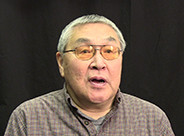Will big companies make billions off a warmer Arctic?
Anchorage, Alaska — Summer temperatures in Alaska have increased by 5 degrees Fahrenheit in the past 30 years, while median winter temperatures have gone up by 10 degrees. Southeast Alaska, during this past January and February, was consistently 8 to 10 degrees warmer than the northeast United States and had no snow whatsoever.
Merlin Koonooka, a Yupik elder from St. Lawrence Island who spoke at the Alaska Anthropological Association’s annual meeting March 4-7 in Anchorage, said that the whales and walruses his people hunt for their subsistence were doing fine, but the “rubble ice” that surrounded the island kept them “inaccessible” to hunters. The permanent ice that used to surround the island is gone, and the yearly ice comes later and is much thinner.
According to Koonooka, fishing lasted longer into the fall, and the composition of the catch has changed. His report agrees with a number of others from across the Arctic: Subsistence hunting has changed, but it is still possible.
Hunting is very important in the culture of Arctic Native peoples. It not only confers status, but sharing the results ties the community together.
International capitalists are intent on developing the Arctic because of the disappearance of the ice cover. (See a graphic depiction of the ice loss by the National Oceanic and Atmospheric Administration at tinyurl.com/klb7ogj.)
The passage through the Northern Sea Route, which is currently in the testing stage, will cut one third of the shipping distance from East Asia to Western Europe.
Given the volume of trade between these two areas, companies that can figure out how to do this safely will save billions of dollars. In 2013, the MS Nordic Orion became the first commercial bulk carrier to transit the Northwest Passage, saving 1,000 miles. (Reuters, Sept. 27) There will certainly be more shipping following the first commercial passage.
But beyond shipping, oil companies and mining companies are placing big bets on developing extractive industries in the Arctic. While the potential profits appear to be immense, the costs and the difficulties involved are also great.
Oil drilling amongst ancient cultures
Shell Oil spent over $6 billion preparing to drill in the Chukchi Sea and Beaufort Sea. Its drilling platform called the Kulluk had to be removed before the ice formed, but in the process of towing it to Seattle, the tow rope broke and the platform got hung up on some rocks. It wasn’t even able to drill a complete test well. (New York Times, Dec. 30)
Whether or not it gets to drill in 2015, Shell will have to spend over $1 billion to preserve its leases.
Nobel Drilling, a subcontractor of Shell, pleaded guilty in early December to eight felony counts for violating environmental and safety laws. The company received over $12 million in fines and community service.
Reading the extensive New York Times coverage of this incident, you can see how absentee executives totally disregarded the conditions their employees and subcontractors faced. They disregarded some simple changes recommended for the tug towing the Kulluk.
The absence of ice, which has a dampening effect on wave formation, has meant that waves have grown much larger. Some of the waves the Kulluk encountered were 50 feet high.
The way that Shell, a huge corporation with very deep pockets, so carelessly treated the Arctic in order to potentially make big profits illustrates how any company, including smaller ones with shallower profits, would behave.
An oil spill in the Chukchi Sea could possible wipe out the habitat for the whales and seals that a number of Inupiaq communities depend on along the shore of the Arctic Ocean. Some of these communities have histories that stretch back a thousand or more years.
The Arctic is not just a wilderness, where companies can rush in and reap massive profits. People have lived there for the past 5,000 years, mainly in nomadic groups chasing after needed resources, like game and seasonal vegetation, but settling in communities when they developed the technology to hunt and process multi-ton whales.
The Native peoples of the Arctic want economic development and the jobs that come with it. But they don’t want economic catastrophes, environmental disasters and destruction of their culture. Their rights must be protected.


